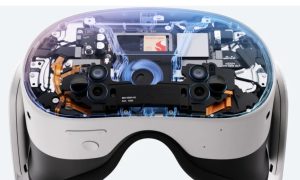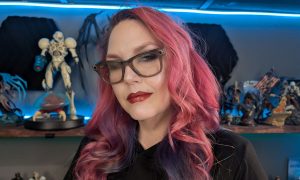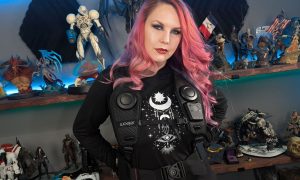 Raven Software did the X-Men franchise proud when they brought the mutant superheroes to life on the original Xbox and PlayStation 2 with X-Men: Legends. Vicarious Visions picked up the mantle and built on it for the successful sequel, X-Men: Legends II. Raven returned to the helm on the Xbox 360 and PlayStation 3 with Marvel: Ultimate Alliance. Blending RPG action with the ability to build out superhero teams from all across the Marvel universe was a big hit with gamers, and Vicarious Visions again took care of business with the successful sequel, Marvel: Ultimate Alliance 2. Activision has been handling the publishing work for all of these titles. This year we get the next installment in the Marvel universe with X-Men Destiny, courtesy of the folks behind Blood Omen: Legacy of Kain, Eternal Darkness: Sanity’s Requiem, and most recently Too Human – Silicon Knights. With current X-Men: Legacy writer Mike Carey behind the pen, and that pedigree of great games behind such a great and storied successful franchise, there is no way this could fail, right? Unfortunately not.
Raven Software did the X-Men franchise proud when they brought the mutant superheroes to life on the original Xbox and PlayStation 2 with X-Men: Legends. Vicarious Visions picked up the mantle and built on it for the successful sequel, X-Men: Legends II. Raven returned to the helm on the Xbox 360 and PlayStation 3 with Marvel: Ultimate Alliance. Blending RPG action with the ability to build out superhero teams from all across the Marvel universe was a big hit with gamers, and Vicarious Visions again took care of business with the successful sequel, Marvel: Ultimate Alliance 2. Activision has been handling the publishing work for all of these titles. This year we get the next installment in the Marvel universe with X-Men Destiny, courtesy of the folks behind Blood Omen: Legacy of Kain, Eternal Darkness: Sanity’s Requiem, and most recently Too Human – Silicon Knights. With current X-Men: Legacy writer Mike Carey behind the pen, and that pedigree of great games behind such a great and storied successful franchise, there is no way this could fail, right? Unfortunately not.
I saw an early version of X-Men Destiny during a trip out to California around May of 2011. The game promised the chance to pick between three fresh faces to the universe that we as players would get to build from the ground up. We would grow our chosen characters by collecting genetic materials and various collectables from other X-Men and Brotherhood members, creating our own uniquely powered superhero as we saw fit. The built was pretty rough as it was very early in development (we weren’t even allowed to play it), but the concept looked sound. The Silicon Knights team promised a heavily story-driven game. Something happened between then and now – I don’t even feel like I’m seeing the same game.
 “Hello Erik. Nice helmet.” – Professor X, X-Men #1
“Hello Erik. Nice helmet.” – Professor X, X-Men #1
X-Men Destiny, as I mentioned above, starts with picking between three different characters that are just about to discover their mutant powers. There is a stereotypical jock meathead with little interest in the sociopolitical species war between humans and mutants, a Japanese girl sent here by her mutant parents for her own safety, and the mutant-hating son of a Purifier who has recently become a part of the anti-mutant group himself. After selecting your character you’ll find yourself at a rally where political powerhouse Mr. Reyes and X-Men leader Cyclops (this game takes place in the the timeline where Professor X is dead, thanks to Bastion) broker an uneasy peace between humans and mutants. When the peace rally inevitably goes completely pear shaped, the player is pushed into a dangerous position, activating their first powers. The first of several choices begins here.
The primary concept of X-Men Destiny is that the player defines their own future. The first decision you’ll make is one of the three power archetypes that’ll define the rest of the game for this character. You have Density Control (heavily armored player dishing damage head to head), Energy Projection (the player lobs balls of lightning, using range to their advantage), and Shadow Matter (high speed blades of ethereal energy project from the player at medium range) as your root power. From there, you’ll eventually select additional powers in that same vein, granting electrical arcs all around you, teleporting warping, a flaming supernova power, incredible strength, and even the ability to turn into an energy wraith capable of descending on your enemies from the sky.
You don’t simply get the powers of Wolverine, Magneto, and other mutants as you progress, instead having to collect them in four parts. As you collect various X-Genes you’ll also pick up outfits, utility genes, as well as offensive and defensive powers. Mixing and matching these items is the big hook of the game, letting you for example, use Pyro’s offensive ability to set enemies on fire with every attack, Magneto’s defensive skill to fly into battle more quickly, wearing Wolverine’s outfit to allow you to regenerate, and Surge’s power to scoot out of battle while showering those in your path with electricity as you pass them. Putting together a complete set for a particular character allows you to unleash their X-Mode, unleashing that particular character’s most powerful moves in addition to your own.
The last major choices in the game are the faction-related ones. You’ll decide pretty frequently whether you’d like to support the X-Men or Brotherhood agenda. Ultimately these are often mini-challenges that you can grind through for additional experience, as well as some sort of X-Gene or outfit reward at the end. Eventually you’ll be asked to make a final faction decision that changes the outcome of the game (to a certain degree) about an hour before the closing credits. The decisions are pretty much cosmetic with only the final scene being a large departure from the X-Men side if you select Brotherhood. It’s getting there that hurts.
“Where would we be without a daily crisis?” – Beast, X-Men #193
I don’t normally write my reviews as a laundry list of things that are wrong, but with X-Men Destiny, I feel like it is warranted. One of the most egregious errors is the inability to skip cutscenes and dialog. In a game that emphasizes a second replay so you can see the alternate ending, it would only make sense that you’d be able to skip the dialog you’ve already heard. This is compounded by an even worse issue – terrible boss battles. The fights with the few bosses in the game are always multi-staged, but when you die (and you will as you will fight them with the health you arrived with) you’ll be transported to before the fight to revisit the same unskippable cutscenes to try again. This leads to unnecessary frustration and the first sign of an unpolished game.
The second sign of an unpolished title is the repetition of content and environments, and X-Men Destiny has both and more. At one point in the game I thought it had hiccupped as the exact same scene unfolded just a moment after we saw it the first time – a full repetition with almost no change. This extends heavily to the enemies in the game. The Purifiers and MRD have almost zero permutations, with almost every enemy being exactly the same as the one before. When one of the challenges asked me to take out 200 troops, it really drove that home for me. Similarly, the subbosses never change in the game – you’ll see the same robots, the same flamethrower-wielding overpowered troops, and the same forcefield shielded giant mech type enemies from start to finish. Unfortunately, this is not the worst of it – you’ll face off against a particular boss type several times and then again as a pathetic unimaginative final boss. The two deviations from these are a fight with John Sublime and a particular boss I won’t ruin for you. The fight with John Sublime was shown during the event I mentioned from several months ago. John Sublime was a research scientist with the U-Men in charge of manipulating mutant genes. The demonstration we saw was story driven, and gave hints that this boss battle might be well linked to the overall story arc. Something happened between then and now – the story has been removed entirely and the only reason I know the name of the boss is that his name appears above his health bar. When you find yourself removing storyline you should ask yourself why…
 Beyond the mechanical issues with the game, there are some cosmetic ones as well. Put simply the game is not pretty. Chunky and ugly textures (even on the player characters), stiff animations, sliding physics (watching boxes literally slide back and forth as if on a boat behind a cutscene with Gambit was particularly funny), constant clipping issues, falling into the water means falling through the ground texture and then reappearing back on the dock, and an unstable framerate throughout the game make me wonder if this game was designed for this generation of game console. Further lack of polish extends to one of the hallmark features of this game – the comic style popups that tell you “Amazing!” or “1 Enemy to go!” and various other combat messages. The messages themselves are great, but the splatter textures around it look like they were made in Microsoft Paint.
Beyond the mechanical issues with the game, there are some cosmetic ones as well. Put simply the game is not pretty. Chunky and ugly textures (even on the player characters), stiff animations, sliding physics (watching boxes literally slide back and forth as if on a boat behind a cutscene with Gambit was particularly funny), constant clipping issues, falling into the water means falling through the ground texture and then reappearing back on the dock, and an unstable framerate throughout the game make me wonder if this game was designed for this generation of game console. Further lack of polish extends to one of the hallmark features of this game – the comic style popups that tell you “Amazing!” or “1 Enemy to go!” and various other combat messages. The messages themselves are great, but the splatter textures around it look like they were made in Microsoft Paint.
“From one catastrophe to the next” – Jean Grey, Uncanny X-Men #270
The controls and sound in X-Men Destiny are a mixed bag. On one end of the spectrum you have a great performance from Magneto, on the other end is a baffling performance from Pixie and Caliban. Similarly, Nightcrawler sounds great as he “BAMFs” into the scene, but when the player character runs it sounds like a horse with a limp on cobblestone, or at least a man with a pair of coconuts imitating the same. The explosions are similarly timid, and when fighting the robots in the game there is no auditory (and most of the time no visual) indication that you are doing any damage until they fall over. One particular instance had me fighting Juggernaut while Magneto and Cyclops battled it out nearby, but I repeatedly heard a woman’s voice inexplicably calling out. It could have been Emma Frost doing something, but without any explanation whatsoever it just didn’t make sense in context.
For the most part, the controls in X-Men Destiny work well. All of the characters engage well, as long as you keep moving and utilize the utility genes to swoop in and out of battle. The characters can unleash their selected powers with the right trigger and the various face buttons. All of the special attacks work, but the Supernova at the high end of the ranged character again lacks any visual or auditory punch, making it pretty dull to slowly meander around pulling enemies into your vortex. Unfortunately there is another aspect of the controls that is simply broken and could not have possibly be missed by QA. The lock-on function highlights an enemy, keeping the camera locked on them, but in no way actually ‘locks on’ to the enemy for targeting. Unless this was a design choice, it just simply doesn’t work. If it is a design choice, it is simply too pointless to bother – I beat the game twice without it.
The main component of the game other than the limited and linear cityscapes are Challenge Arenas. The Arenas (with only a very few exceptions) are simply timed unimaginative enemy-vomiting enclosed spaces, asking the player to defeat increasing amounts of enemies under a very relaxed time constraint. Occasionally you’ll get a cryptic message to take out the “Active” enemies, which means ignore all of the generic troops and take out the robots or other mechanical foozles in the space. Any way you slice it, it underscores the formulaic repetition of guys with shock sticks, guys that jump, guys that throw grenades, a flamethrower guy, a robot, a shielded robot, and then a mutant gene reward. You’ll follow this pattern throughout the roughly 5 hours it takes to beat the game, and again for another 5 hours if you choose to see the second ending.
“The day ya stop changin’ –is the day ya die.” – Wolverine, Uncanny X-Men #337
I completely applaud Silicon Knights for trying something new. A new and fresh face for the player, a unique way to engage the mutant powers, and a story that follows the current timeline of the X-Men universe were solid goals. Unfortunately it feels like Silicon Knights wrote the story on the back of a cocktail napkin and employed absolutely zero imagination in building the enemies we’d be facing. Repetition of literally everything in the game ad nauseum, a blocky-textured engine that couldn’t hold a stable framerate under any circumstances, and unfinished and unpolished features round out a title that clearly needed another year of development. When I look over at my shelf and see games like Marvel: Ultimate Alliance and its sequel, I can’t help but feel like the X-Men deserve so much better.
Ron Burke is the Editor in Chief for Gaming Trend. Currently living in Fort Worth, Texas, Ron is an old-school gamer who enjoys CRPGs, action/adventure, platformers, music games, and has recently gotten into tabletop gaming.
Ron is also a fourth degree black belt, with a Master's rank in Matsumura Seito Shōrin-ryū, Moo Duk Kwan Tang Soo Do, Universal Tang Soo Do Alliance, and International Tang Soo Do Federation. He also holds ranks in several other styles in his search to be a well-rounded fighter.
Ron has been married to Gaming Trend Editor, Laura Burke, for 28 years. They have three dogs - Pazuzu (Irish Terrier), Atë, and Calliope (both Australian Kelpie/Pit Bull mixes), and an Axolotl named Dagon!

See below for our list of partners and affiliates:
























